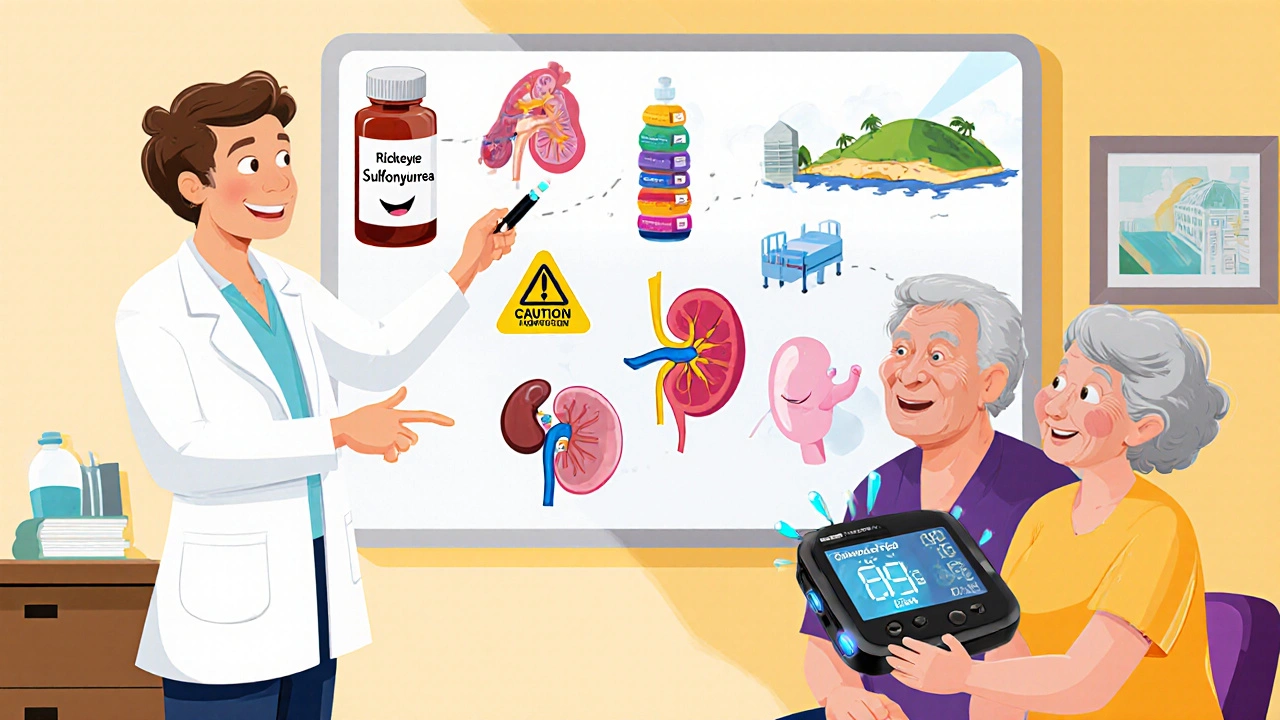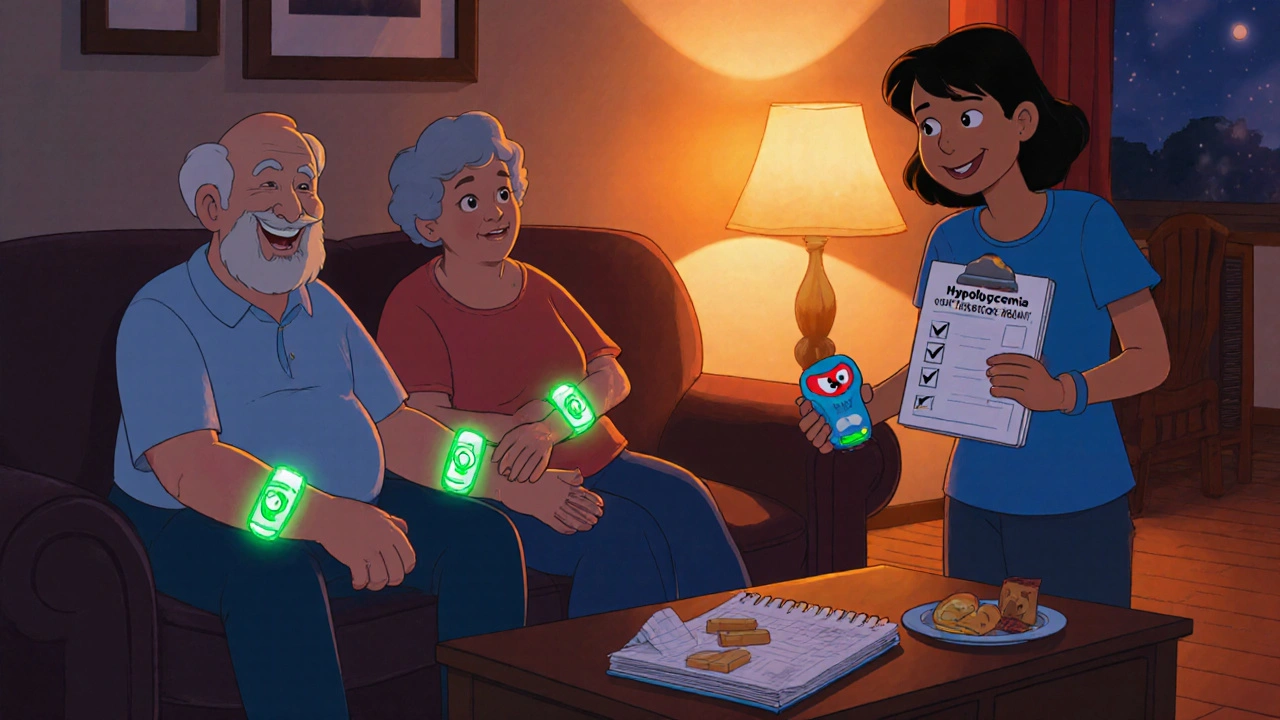Hypoglycemia Risk Calculator for Older Adults
This tool helps assess hypoglycemia risk based on key factors mentioned in the article. Higher scores indicate greater risk of dangerous low blood sugar episodes in older adults.
Your Hypoglycemia Risk Assessment
Low blood sugar isn’t just a nuisance for seniors-it can trigger falls, fractures, heart problems, and even speed up cognitive decline. Understanding why older adults are especially vulnerable and how to stop dangerous lows before they happen is essential for anyone caring for an elderly person with diabetes.
Why Age Changes the Hypoglycemia Game
When blood glucose drops below 70 mg/dL, the body normally launches a counter‑attack: adrenaline, glucagon, and cortisol push sugar back into the bloodstream. In people over 65, those hormonal defenses are blunted by 30‑50% (Crandall et al., 2015), meaning lows can plunge deeper before any warning signs appear. Add in slower gastric emptying, reduced kidney clearance of insulin, and a higher chance of malnutrition, and the stage is set for “perfect‑storm” hypoglycemia.
Older adults also often experience hypoglycemia unawareness - a condition where classic autonomic symptoms like sweating or tremor are muted - affecting roughly 25% of seniors with type 1 diabetes and 15‑20% with type 2 (NIH, 2015). Without those early cues, neuroglycopenic symptoms (confusion, dizziness, even seizures) can arrive suddenly, increasing the risk of severe events that need assistance (ADA Level 3).
Key Risk Factors to Watch
Think of risk factors as a checklist that often overlaps in the elderly. The NIH lists 14, but the most common culprits are:
- Insulin or sulfonylurea therapy - especially long‑acting agents like glyburide
- Chronic kidney disease (eGFR < 60 mL/min/1.73 m²) - raises severe hypoglycemia odds by 2.7‑fold (Endocrine Society, 2023)
- Multiple medications (≥5) - drug‑drug interactions can amplify insulin effects
- Recent hospitalization or acute illness - changes appetite and medication timing
- Dementia, depression, or social isolation - impair self‑monitoring and prompt treatment
When two or more of these coexist, the probability of a low‑blood‑sugar episode skyrockets.
Consequences That Matter
Every hypoglycemic episode nudges older adults closer to serious outcomes. Studies show a 40% rise in fall risk, a 25% increase in hip‑fracture incidence, and a 30% jump in cardiovascular events after a low event (NIH, 2015). A five‑year follow‑up of 782 seniors revealed that those with severe lows faced a 2.5‑times higher mortality rate, though part of that risk stems from underlying frailty.
Beyond acute injuries, recurrent lows chip away at cognition. One analysis linked frequent hypoglycemia to a 1.8‑fold higher chance of new cognitive impairment within two years (Aging & Disease, 2014). In practical terms, a senior who keeps slipping into low glucose may lose independence faster than a peer with stable glucose control.
Building a Multicomponent Prevention Plan
The American Diabetes Association (ADA) 2024 Standards of Care call for a layered approach: education, medication review, and individualized targets. The idea isn’t to drive A1c down to 6.5% at any cost, but to keep glucose in a safer band while preserving quality of life.
Key steps include:
- Document each patient’s hypoglycemia history - dates, severity, triggers.
- Score risk factors using tools like the TRIM‑HYPO questionnaire (treatment‑related impact measure).
- Set a realistic A1c target - <70 % time‑in‑range 70‑180 mg/dL for healthy seniors, up to <8.5 % for frail individuals.
- Adjust medications (see table below).
- Introduce or optimize continuous glucose monitoring (CGM) - aiming for <1 % time <54 mg/dL and >50 % time 70‑180 mg/dL.
- Teach caregivers the “15‑15‑15” rule (15 g carbs, re‑check in 15 min, repeat if still low) and glucagon administration.

Medication Review: Choosing Safer Options
Not all diabetes drugs carry the same low‑blood‑sugar danger. Below is a quick comparison that helps clinicians and families decide which agents to keep, taper, or replace.
| Medication Class | Typical Hypoglycemia Risk | Notes for Seniors |
|---|---|---|
| Long‑acting insulin (glargine, detemir) | High | Consider dose reduction or basal‑bolus simplification; monitor bedtime glucose. |
| Second‑generation sulfonylureas (glipizide, gliclazide) | Medium‑High | Shorter half‑life than glyburide; still requires caution. |
| Metformin | Low | Safe for most seniors; watch for renal function. |
| DPP‑4 inhibitors (sitagliptin, linagliptin) | Low | Weight neutral, minimal hypoglycemia when used alone. |
| GLP‑1 receptor agonists (exenatide, semaglutide) | Low | May cause GI side‑effects; avoid if swallowing is an issue. |
| SGLT2 inhibitors (empagliflozin, canagliflozin) | Very Low | Risk of dehydration; monitor for urinary infections. |
Whenever possible, shift patients toward low‑risk agents, especially if they have CKD, frailty, or a history of severe lows.
Glucagon and Emergency Preparedness
Even with the best plan, occasional severe lows happen. Glucagon emergency kits - injectable or nasal - give caregivers a rapid way to raise glucose when a person can’t swallow. Training caregivers on dosage (1 mg for injection, 3 mg nasal) and when to call emergency services reduces mortality and prevents prolonged neuroglycopenia.
Technology Boost: Continuous Glucose Monitoring
CGM adoption among seniors is still under 15%, but the payoff is big. The ADA reports a 40% drop in severe hypoglycemia when CGM is used (2024). Devices like Dexcom G7, Abbott FreeStyle Libre 3, and Medtronic Guardian 4 provide real‑time alerts, trend graphs, and “low‑glucose suspend” features that automatically stop insulin delivery.
Medicare now covers CGM for insulin‑treated seniors, yet many on sulfonylureas remain excluded, even though they’re high‑risk. Advocating for broader coverage can make a difference for thousands of older adults.

Lifestyle Tweaks and Caregiver Tips
Simple daily habits cut down low events:
- Consistent meal timing - avoid skipping breakfast; consider a bedtime snack if prone to nocturnal lows.
- Gentle physical activity - encourage walking but advise checking glucose before and after.
- Hydration - dehydration can mask symptoms and raise insulin concentration.
- Medication synchronization - align pill times with meals to reduce confusion.
Caregivers should keep a log of glucose readings, symptoms, and food intake. Sharing that log with the primary care provider every 2-3 months helps fine‑tune therapy.
Step‑by‑Step Implementation Guide
- Assess baseline: Pull the last 12 months of glucose logs, medication list, renal and liver labs.
- Score risk: Apply a checklist (age > 75, CKD, sulfonylurea use, history of severe lows).
- Set target A1c: Choose <7% for robust seniors, up to <8.5% for frail or limited life expectancy.
- Adjust meds: Stop or reduce insulin and long‑acting sulfonylureas first; introduce metformin or DPP‑4 inhibitors as needed.
- Introduce CGM: If affordable, start a CGM trial; set alerts at 70 mg/dL.
- Educate: Conduct a 30‑minute session on low‑symptom recognition, the 15‑15‑15 rule, and glucagon use.
- Follow‑up: Re‑evaluate in 4-6 weeks, adjust doses based on CGM trends, and document any hypoglycemia events.
Sticking to this roadmap cuts the odds of severe lows by nearly half, according to the Pottstown Primary Care Intervention study.
Economic Impact and Health‑System Burden
Each severe hypoglycemia episode costs about $1,200 in emergency care, and the US sees roughly 100,000 ED visits and 30,000 hospitalizations annually among seniors (ADA, 2024). With the aging population projected to reach 80 million over 65 by 2040, avoiding even a fraction of those events would save billions and keep older adults living safely at home.
Looking Ahead: Emerging Solutions
Future tech aims to automate prevention. The FDA’s 2023 approval of a dual‑hormone artificial pancreas (insulin + glucagon) is entering trials with older participants, promising closed‑loop control that could virtually eliminate lows. Meanwhile, research is shifting the focus from A1c to “time‑in‑range” as the primary metric for seniors, with the ADA targeting <1 % time < 54 mg/dL.
Until those innovations become widespread, the best defense remains a patient‑centered plan that blends medication safety, CGM insights, caregiver education, and realistic glucose goals.
What blood glucose level defines hypoglycemia in older adults?
The ADA sets Level 1 hypoglycemia at 54‑69 mg/dL, Level 2 below 54 mg/dL, and Level 3 as a severe event requiring help.
Why are sulfonylureas risky for seniors?
They stimulate insulin release regardless of glucose level, and long‑acting agents like glyburide have a high hypoglycemia risk, especially with reduced kidney function.
How does continuous glucose monitoring help older adults?
CGM provides real‑time alerts, trend data, and low‑glucose suspend features that can prevent severe lows, cutting hypoglycemia rates by about 40% in seniors.
What should caregivers do during a severe low?
Administer glucagon (1 mg injection or 3 mg nasal), call emergency services if consciousness doesn’t return within minutes, and stay with the person until fully recovered.
Can A1c targets be relaxed for frail seniors?
Yes. The ADA recommends <8.5% for those with multiple comorbidities or limited life expectancy, focusing on safety over tight control.

Comments
Shawna B
So low sugar makes old folks dizzy and fall? That sounds bad.
On October 26, 2025 AT 09:16
Jerry Ray
They should just stop taking insulin if it’s making them weak. Simple fix.
On October 28, 2025 AT 06:56
Krys Freeman
Another government-funded scare tactic. Seniors have been fine for centuries before this diabetes panic.
On October 29, 2025 AT 09:57
Sophia Lyateva
Big Pharma made this up so they could sell more glucose monitors and insulin pens. They don’t want you to know the truth.
On October 29, 2025 AT 13:34
Craig Ballantyne
The pathophysiological underpinnings of age-related hypoglycemia unawareness are well-documented in endocrine literature, particularly in the context of diminished counterregulatory hormone secretion. The clinical implications are non-trivial.
On October 29, 2025 AT 15:42
Lyn James
People these days treat aging like a disease to be managed with pills and gadgets. Back in my day, we ate real food, worked hard, and didn’t need a 14-point checklist to avoid a little dizziness. Weakness is a choice, not a diagnosis.
They let seniors take five medications because doctors get paid per script, not per outcome. It’s a system designed to fail.
And now we’re told to lower A1c? That’s like telling a drowning man to swim faster. The body isn’t broken-it’s being over-medicalized.
Real health isn’t measured in glucose numbers. It’s measured in laughter, in walking the dog, in remembering your granddaughter’s name. Not in some lab report.
They’re turning old age into a clinical trial. And we’re the subjects.
Why not just let people live? Why does everything have to be optimized, quantified, and pathologized?
My grandfather lived to 92 on a plate of beans and cornbread. He never checked his blood sugar. He didn’t need to.
We’ve lost something fundamental. We’re afraid of the natural process of aging, so we medicate it into submission.
And now we’re blaming the patient when they fall. It’s not their fault. It’s the system’s.
They say ‘individualized targets’-but what they really mean is ‘we’ll treat you differently depending on how much insurance you have.’
Stop pretending medicine is science. It’s big business with a white coat.
On October 31, 2025 AT 09:11
AARON HERNANDEZ ZAVALA
I’ve seen this with my dad. He’s 81, on metformin and a tiny bit of insulin. He forgets to eat sometimes after his nap. One time he passed out in the kitchen. Scared the hell out of us.
We switched him to glimepiride and now he eats a snack every time he gets up. Simple. But nobody told us until it happened.
It’s not about being perfect. It’s about being safe.
On November 1, 2025 AT 23:13
David Ross
Of course the government and the pharmaceutical industry want you to believe this is a crisis-because they profit from your fear. They sell glucose monitors, insulin pens, and endless blood tests. They don’t want you to know that fasting, whole foods, and movement are the real solutions. They want you dependent.
And now they’re telling you your grandmother’s natural aging process is a medical emergency? That’s not science-that’s corporate manipulation.
My uncle took no medications. He ate vegetables, walked every day, and lived to 96. He never checked his blood sugar. He didn’t need to.
Stop buying into the diabetes industrial complex.
On November 3, 2025 AT 02:35
Nicholas Swiontek
My mom had a scary low last year-no warning, just slurred speech and confusion. We started giving her a protein bar before bed and now she’s fine. No drama, just common sense.
Also, check if she’s on glyburide. If yes, ask the doc about switching. It’s a known risk.
You got this 💪
On November 4, 2025 AT 02:29
Shannon Wright
This is such an important topic-and so often overlooked. I work in geriatric care, and I see this over and over: seniors on multiple meds, living alone, forgetting meals, and no one checking in. Hypoglycemia isn’t just a diabetic issue-it’s a social issue.
One of our patients, Mrs. Delgado, had three severe lows in six months. Turns out, she was skipping lunch because she couldn’t afford groceries and didn’t want to ask for help.
We connected her with Meals on Wheels, switched her from sulfonylurea to a GLP-1 agonist, and added a simple alarm on her phone to remind her to eat. She hasn’t had a low since.
It’s not always about the medicine. Sometimes it’s about making sure someone remembers to eat. Or has someone to call when they feel off.
We need more community support, not just more glucose meters.
And yes, A1c targets should be individualized. For some, 7.5% is perfect. For others, 8.0% is the goal. Safety over perfection.
If you’re caring for an older adult, ask: Do they know the signs? Do they have food nearby? Do they have someone who checks on them? Those questions matter more than any lab value.
On November 5, 2025 AT 21:33
Sakthi s
Good info. Simple steps help a lot. Snacks, check meds, watch for confusion. Elderly need care, not just numbers.
On November 7, 2025 AT 15:30
Victor T. Johnson
They say ‘individualized targets’ but what they really mean is ‘we’ll treat you like a statistic until you die.’
My grandma had a low and the hospital gave her a pump. She didn’t want it. She just wanted to sit in the sun.
Medicine forgot that people aren’t machines 😔
On November 8, 2025 AT 02:17
vanessa parapar
Of course you’re going to have problems if you’re on glyburide. That drug is ancient. It’s like prescribing leeches. Any doctor who still prescribes it shouldn’t be allowed near a diabetic patient.
On November 9, 2025 AT 21:21
Robert Asel
While the epidemiological data presented is statistically significant, the underlying assumption-that hypoglycemia is an independent predictor of mortality-is confounded by reverse causality. Frailty, not hypoglycemia, is the primary driver of adverse outcomes. The paper fails to adequately adjust for functional status, albumin levels, and comorbidity burden. A superficial interpretation of this data could lead to clinically inappropriate de-escalation of therapy.
On November 10, 2025 AT 14:57
Rachel Nimmons
They’re watching you. The glucose monitors track your habits. The insulin companies sell your data. You think this is about health? It’s about control.
On November 11, 2025 AT 20:39
Ben Wood
And yet, the ADA's 2024 guidelines remain dangerously naive. They advocate for ‘individualized targets’ while ignoring systemic failures: lack of home care, inaccessible nutrition, and the erosion of intergenerational support. This isn’t a medical problem-it’s a societal collapse dressed in clinical jargon.
They want you to check your glucose… but not fix the food deserts. They want you to take a pill… but not pay your caregiver. They want you to ‘manage’ your disease… but not give you dignity.
Real prevention? It’s not a questionnaire. It’s a living wage. It’s a neighbor who checks in. It’s a family that doesn’t abandon its elders.
Stop blaming the patient. Start blaming the system.
On November 13, 2025 AT 05:58
Bethany Hosier
It is imperative to acknowledge the profound and multifaceted implications of age-related hypoglycemia, as elucidated in this meticulously researched exposition. The confluence of diminished counterregulatory responses, polypharmacy, and social isolation constitutes a veritable trifecta of vulnerability. One must, however, also consider the ethical dimensions of medical intervention in the geriatric population-where autonomy, beneficence, and non-maleficence must be delicately balanced. The imposition of rigid glycemic targets, while statistically sound, may inadvertently compromise quality of life. It is not merely a matter of glucose values, but of human dignity. The TRIM-HYPO tool, while innovative, must be contextualized within the lived experience of the elderly, not reduced to a checklist. In sum, the path forward lies not in technological surveillance, but in compassionate, holistic care-where the person, not the parameter, remains paramount.
On November 14, 2025 AT 05:16
AARON HERNANDEZ ZAVALA
My mom’s doc switched her from glyburide to glipizide after she had a low. Big difference. No more scary episodes. Just make sure the doctor listens.
On November 15, 2025 AT 21:10